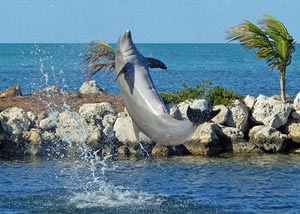Atlantic spotted dolphins
The first recorded encounters between people and Atlantic spotted dolphins along the Little Bahamas Bank was in the late 1960's when divers were salvaging the wreck of a Spanish galleon. Divers were frequently visited by friendly spotted dolphins that would approach, investigate, and often mimic divers' actions. In the mid-1980's, scientists began studying their distribution, associations with one another, behavior, even identifying individuals by gender and the pattern of their spots. Beginning at about four years old, young dolphins in this species begin developing black spots on their light underside and white spots on their dark topside. The older the dolphin, the more spots.
Atlantic spotted dolphins live in the shallow, tropical waters off the Atlantic Coast of the United States, the Gulf of Mexico, and the Bahamas. It is when they're near-shore that Kathleen studies them. During the afternoon, they swim out to deeper waters in search of fish and squid. Atlantic spotted dolphins are relatively small compared to other dolphins. They are about six feet long and weigh approximately 200 pounds when they reach adulthood. The females of this species are generally larger than the males.
-------------------------------------------------------------------------------------
Dusky dolphins
Duskies are smaller than many dolphins, reaching a length of five to six or so feet. They have very short beaks and distinctive black and white coloring, but the most noted characteristic of the duskies is their highly acrobatic leaps. In addition to helping propel them more quickly through the water, duskies may be leaping for their dinner. By leaping high, they may be locating their prey by spotting flocks of birds feeding on schooling fish, sometimes miles away. These leaps also might communicate to other dolphins that dinner is near.
The dolphins begin their search for food in groups of 20 or more. Würsig thinks that duskies watch for birds circling above the water and feeding on fish as a signal that anchovies are near. The several groups then race toward the school of anchovies and begin cooperatively herding the fish into a swirling school. The dolphins drive the fish toward the ocean's surface, using it as a barrier or wall that the anchovies cannot escape. At this point, there may be hundreds of dolphins working together to herd and consume the anchovies. The duskies call to one another in loud, excited squawks and whistles, leaping and slapping the water with their tails as they take turns herding and feeding.
--------------------------------------------------------------------------------
Bottlenose dolphins
The 1960's television show "Flipper," as well as oceanariums that care for captive dolphins, have made the bottlenose the most recognized dolphin species in the world. In fact, bottlenose dolphins inhabit temperate and tropical waters of almost every ocean, including the Mediterranean Sea and the Gulf of Mexico. Their popularity and anatomical "smile" cause many people to think dolphins are merry, friendly creatures eager to interact with humans. In some respects this is true. Dolphins are highly social animals, and in captivity, they tend to be eager to interact with humans and are more easily trained than other animals. Even in the wild, there have been many documented accounts of dolphins seeking human companionship, but generally speaking, they far prefer the company of their own kind. Why some dolphins separate from their group and interact with people is still a mystery.
Bottlenose dolphins are much bigger than spotteds and duskies. At about ten feet long and 600 pounds, dolphins can be quite aggressive with one another and with other species, including humans. Several people have been injured and one person killed by a dolphin, but the blame often falls on the humans who don't understand how their actions can be interpreted as aggressive by the dolphin. It's interesting to know that the "killer whale," the largest of all dolphins, has never been known to kill a person. They are the top predator in the oceans, but have not harmed people.
While swimming with dolphins is illegal in U.S. waters, "swim with dolphin" programs are abundant and becoming more popular in other locations. Scientist Kathleen Dudzinski spent this last year in Japan studying bottlenose dolphins in an area that's becoming more popular with tourists as a "swim with dolphins" destination. Behaviors and life cycles, as well as their feeding and rest patterns, so that we don't disrupt their lives, or cause injury to dolphins or ourselves.
--------------------------------------------------------------------------------





